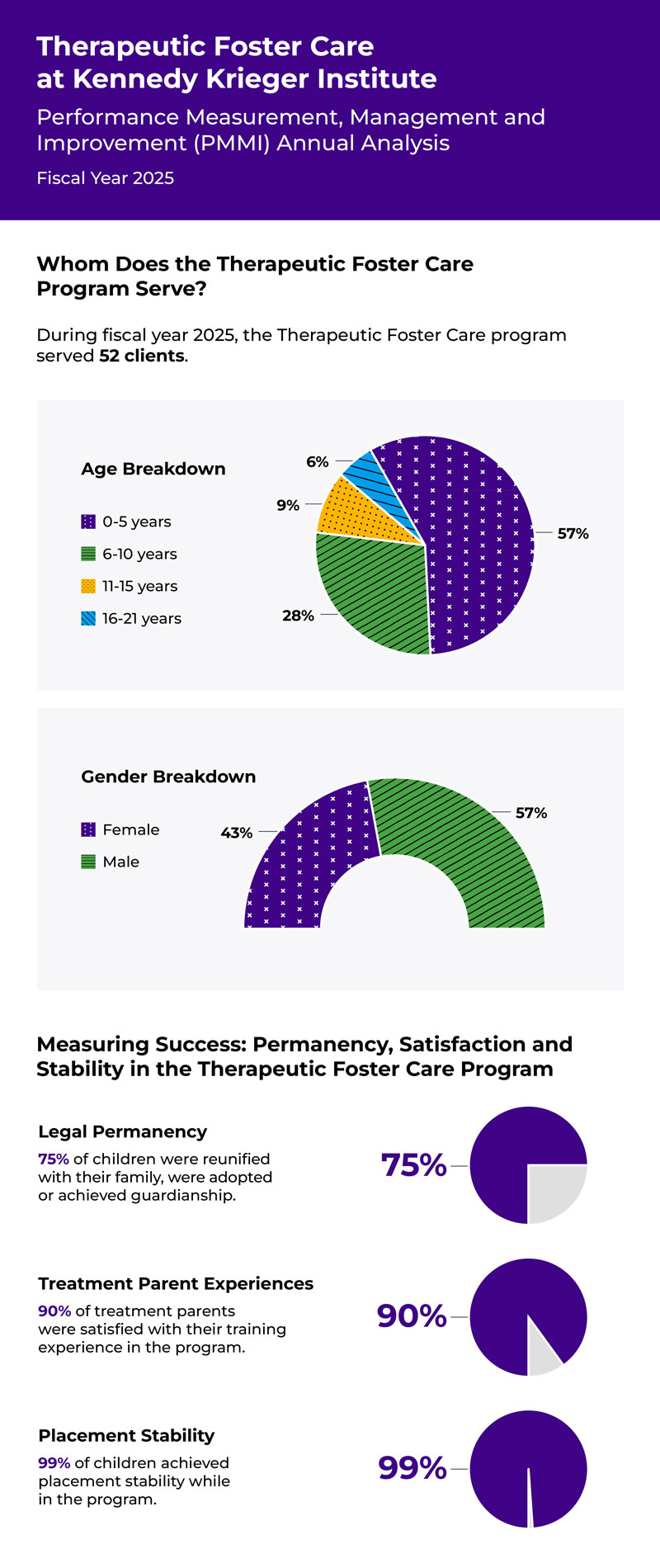What is the Trauma Integrative Model?
The Trauma Integrative Model (TIM) developed by the TFC program combines elements of the evidenced-based Multidimensional Treatment Foster Care (MTFC) model with other evidence-based and best practice models that address issues of complex trauma, transition age youth, permanency, developmental disabilities and medically fragile conditions of youth placed in out of home care. The TIM also integrates the core principles of Systems of Care and Maryland’s Family Center Practice Model, which focus on youth safety, permanency and well-being. The TIM is unique in how these elements are integrated to create a “focus of change,” the role of the TFC Social Worker as primary clinician and the way in which the program supports the efforts of those involved in the treatment of the youth.
How the Model Works
The TIM integrates the treatment of child, family, and treatment parent within the “focus of change.” The primary role of the treatment foster care worker in the TIM is that of Clinical Social Worker (CSW). In this role, CSW acts as the primary clinician or therapist for child and family, treatment team leader, trainer, and supervises the treatment parent in their role. Like other TFC models the treatment parent is the change agent for the child. However, unlike other models the treatment parent role in the TIM includes:
- Working with the child and their family to achieve permanency goals;
- Case management, including advocating for services that address the child’s educational, medical and mental health needs
- Ensuring the child is actively engaged in appropriate educational, recreational, employment, volunteer, and other age and developmentally appropriate community activities.
The Trauma Integrative Model (TIM) - Outcomes
Children and youth placed in the TFC program, who were previously placed in more restrictive environments, were twice as likely to be discharged to less restrictive environments (Jamora, Brylske et al., 2010). The majority of children and youth served (60%) were discharged to permanent families (adoptive, biological, and kin). This percentage of discharges to permanency increased to 77% in fiscal year 2011 and to 75% in fiscal year 2012. The rates of adoption were 28% and 25% for the respective years compared to 20% for those in standard foster care. The rate of placement change (movement within the program (Royes et al 2007), transfer among foster families) of youth served is 53% lower than evidenced by these youth prior to placement in TFC (Brylske, Rogers & Belcher 2010).
In a preliminary study of the TIM (Jamora, Brylske et al. 2010), over eighty-five percent of the children served were referred by the Baltimore City Department of Social Services. The majority of the children served are African American (84.8%) and male (65.2 %). The mean age of the children (N=138) served was 8.9 years (SD 3.3). The children, on average, experienced over 5 ACEs (SD 2.5). The four most prevalent child maltreatment experiences for children are physical abuse (65.9%), sexual abuse (50.0%), abandonment (39.9%) and emotional abuse (21%). The primary DSM-IV-R diagnosis (in descending order) of the children are ADHA, ODD, depressive disorders and PTSD. Approximately one third of biological mothers had a history of alcohol abuse, one fifth had a history of mental health disorders, over two thirds had illicit substance abuse and nearly two third had a history of incarceration.
The rate of placement change during TIM TFC was 53% lower than the rate of placement change prior to TIM TFC (Royes, Brylske et al., 2007)
Placement changes have decreased and maintained since this study. The rate of placement change was 49% lower for children with a history of parental illicit drug use history compared to children without a history of parental drug abuse.
The majority of children (60%) enrolled in the TIM TFC program were discharged to less restrictive placements, with nearly half of those going to families and kin (Jamora et al., 2010). Of the children coming from more restrictive placements 60% were also discharged to less restrictive placements. The odds of having a more restrictive placement at entry were 2.6 times greater than a more restrictive placement at discharge.
The TIM TFC has shown to be effective in the number of youth achieving permanency especially with respect to adoption
Ninety – eight per cent (98%) of the youth in the TFC Program complete high school with a diploma or certificate. This is a much higher average than reflected in the literature in foster care as well as in Maryland.
Finally, a recent unpublished study comparing changes in CANS Score for 104 children served by the TFC Program showed statistically significant positive changes in CANS domains scores at discharged when compared to scores at discharge .
Additional outcomes and measures will be developed in the development of the TIM as an evidence-based practice. The program is currently involved with consultants from Advance Metrics supporting this effort along with the research staff at Kennedy Krieger.
Outcome Data

